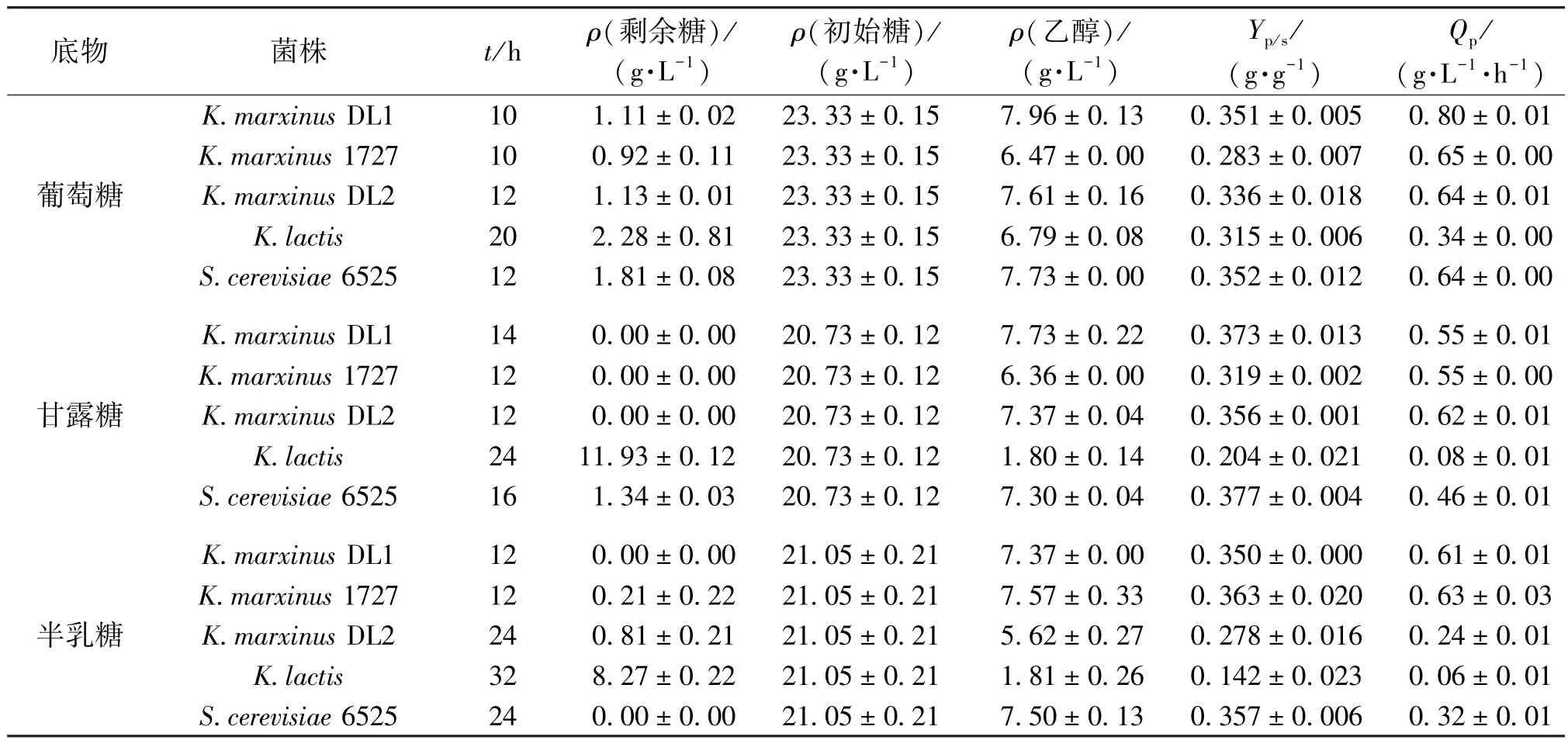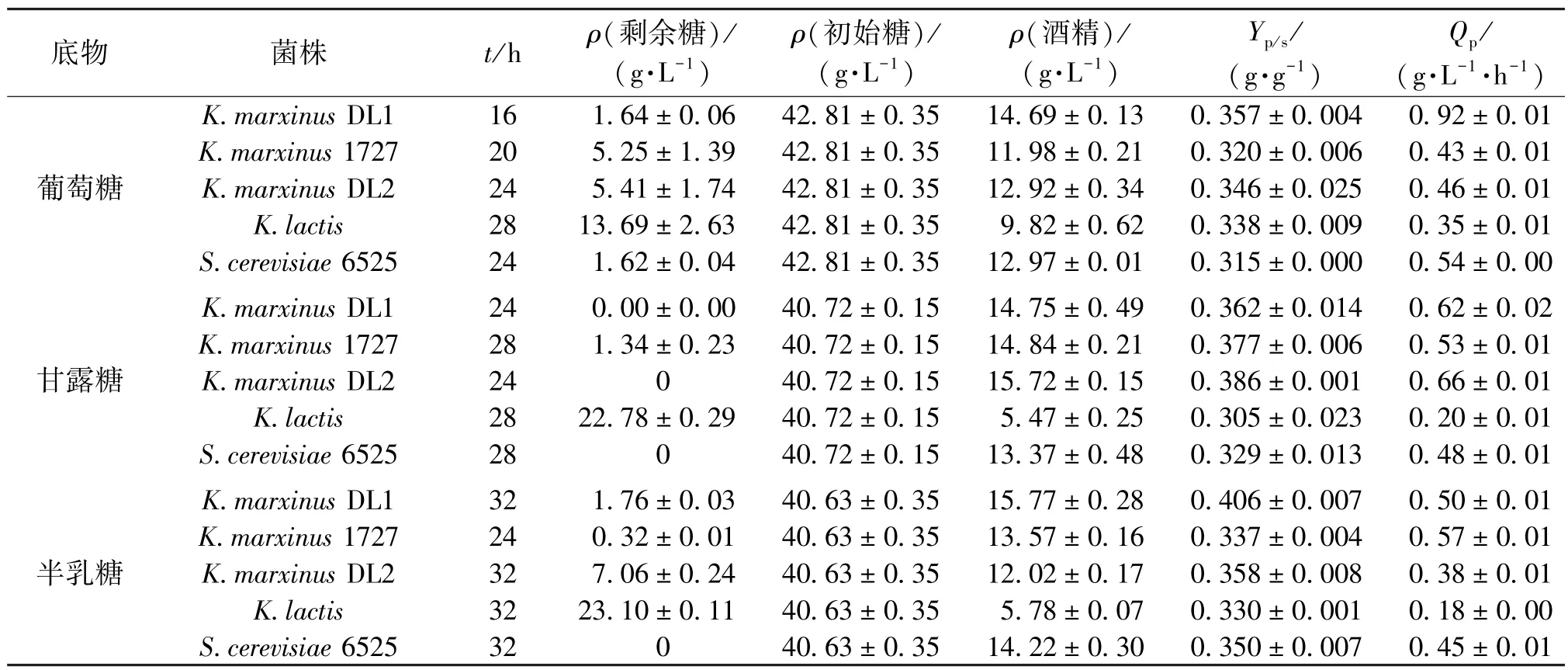Kluyveromyces marxianus发酵己糖和戊糖生产乙醇
韩锡铜,高教琪,陈丽杰,袁文杰,白凤武
(大连理工大学 生命科学与技术学院,辽宁 大连 116023)
Kluyveromyces marxianus发酵己糖和戊糖生产乙醇
韩锡铜,高教琪,陈丽杰,袁文杰,白凤武
(大连理工大学 生命科学与技术学院,辽宁 大连 116023)
对利用底物广泛的乙醇发酵菌株马克斯克鲁维(Kluyveromyces marxianus)DL1菌株与工业用乙醇发酵菌株酿酒酵母(Saccharomyces cerevisiae)6525利用己糖(葡萄糖、甘露糖、半乳糖)和戊糖(木糖、阿拉伯糖)的情况进行对比研究。结果发现:以己糖为底物时,K.marxianus DL1均表现出细胞生长快、乙醇得率高的特点;在不通气、糖20 g/L条件下,K.marxianus DL1的最大乙醇质量浓度均比S.cerevisiae 6525高出10%左右,细胞量及乙醇生产强度分别是S.cerevisiae 6525的近2和1.7倍。当以戊糖为底物时,K.marxianus DL1可以利用木糖和阿拉伯糖;在不通气、糖20 g/L条件下,K.marxianus DL1利用木糖产木糖醇和乙醇,乙醇终质量浓度可达7.68 g/L,木糖醇质量浓度为9.12 g/L;以阿拉伯糖为发酵底物时,阿拉伯糖醇的产量可达6 g/L左右;而S.cerevisiae 6525不能利用戊糖。马克斯克鲁维酵母比酿酒酵母更适合纤维乙醇生产。
马克斯克鲁维酵母;酿酒酵母;乙醇发酵;戊糖;己糖
迄今为止,燃料乙醇是研究最热且被公认为拥有广阔发展前景的生物清洁能源之一[1]。目前,大规模投入生产的原料是以淀粉和糖类为主,然而,“不与人争粮,不与粮争地”的基本国策严重限制了燃料乙醇的规模化生产[2-3]。
木质纤维素生物质是当今世界上来源丰富、价格低廉、可再生性的生物质原料,其主要成分包括纤维素、半纤维素和木素。在植物纤维中,纤维素和半纤维素占到原料干质量的50%以上[4],分解产物分别为葡萄糖、甘露糖、半乳糖等己糖以及木糖、阿拉伯糖等戊糖[5]。与葡萄糖相比,大量的戊糖资源尚未得到同等有效利用,成为纤维原料生产燃料乙醇的关键之一。
Kluyveromyces marxianus属于非常规酵母,利用其高温特性和能够发酵多种底物的特点而进行的乙醇发酵已引起了国内外学者的广泛关注[6-8]。早在20世纪80年代,就有关于K.marxianus发酵木糖的报道,但由于乙醇产率较低,未能引起重视[9]。随着纤维素乙醇的发展及对K.marxianus认识的加深,人们对K.marxianus在纤维素乙醇转化中的应用重新提上日程。Watanabe等[10]将来源于不同酵母的木糖转运蛋白在K.marxianus中表达,一定程度上提高了K.marxianus代谢木糖的速率。国内洪炯课题组首次鉴定了K.marxianus代谢木糖途径的3个重要基因:木糖脱氢酶[11]、木酮糖激酶[12]及木糖醇还原酶[13],为研究K.marxianus在发酵木糖中的应用奠定了一定基础。但由于这些菌株的产乙醇性能较差,尚不能满足工业化应用要求。
笔者将本实验室成员自行选育得到的能够发酵木糖的K.marxianus菌株以及工业用乙醇发酵菌株S.cerevisiae 6525在不同C源条件下的生长、发酵状况进行研究对比,以期筛选出更具有优势的乙醇生产菌种,使其能够较高效地发酵戊糖(木糖、阿拉伯糖),使之具有成为纤维素乙醇生产菌株的潜力。
1 材料与方法
1.1 材料
1.1.1 菌株
马克斯克鲁维酵母 Kluyveromyces marxianus DL1和 DL2,本实验室成员筛选;Kluyveromyces marxianus 1727、乳酸克鲁维酵母 Kluyveromyces lactis,购自中国工业微生物保藏中心,编号分别为1727和1772;酿酒酵母Saccharomyces cerevisiae 6525(工业界赠送)。以上菌株由大连理工大学生命科学与技术学院保藏。
1.1.2 培养基
平板培养基(g/L):糖类20(葡萄糖、木糖、阿拉伯糖、甘露糖和半乳糖),酵母粉10,蛋白胨20,琼脂粉18。
活化培养基(g/L):葡萄糖20,酵母粉10,蛋白胨20。
种子培养基(g/L):葡萄糖20,(NH4)2SO45.0,KH2PO43.0,MgSO4·7H2O 0.5,微量元素(EDTA 0.015,ZnSO4·7H2O 0.004 5,MnCl2·2H2O 0.000 84,CoCl2·6H2O 0.000 3,CuSO4·5H2O 0.000 3,Na2MoO4·2H2O 0.000 4,CaCl2·2H2O 0.004 5,FeSO4·7H2O 0.003,H3BO30.001,KI 0.000 1),生物素0.000 05,泛酸钙0.001,烟酸0.001,肌醇0.025,维生素B1 0.001,维生素B6 0.001,对氨基苯甲酸0.000 2。
生长培养基(g/L):糖类20(葡萄糖、木糖、阿拉伯糖、甘露糖和半乳糖),其余成分同种子培养基。
发酵培养基(g/L):糖类40(葡萄糖、木糖、阿拉伯糖、甘露糖和半乳糖),其余成分同种子培养基。
1.2 实验方法
1.2.1 菌株培养
经过两级种子活化,将种子液以10%的体积分数接入有效体积为100 mL的摇瓶培养基中,摇瓶分别用8层纱布(微量通气)和厌氧塞封口(不通气)。30℃、150 r/min培养。定时取样,测定生物量、糖以及各种代谢产物浓度。
1.2.2 分析方法
生物量测定方法:采用OD值法,将菌液适当稀释,在波长为620 nm处测定其吸光值。
发酵液代谢产物的分析:发酵液在 10 000 r/min下离心5 min,取上清液,用孔径为0.22 μm的水膜过滤,利用高效液相色谱(HPLC)测定葡萄糖、甘露糖、半乳糖、木糖、阿拉伯糖、木糖醇、阿拉伯醇、甘油、乙酸和乙醇的含量。色谱柱的型号为Aminex HPX-87H。流动相为0.01 mol/L H2SO4水溶液,流速0.5 mL/min,分别使用紫外检测器(检测波长205 nm)和示差检测器。
1.2.3 数据分析方法

2 结果与讨论
2.1 在平板培养条件下C源对菌株生长的影响
将具有较好发酵乙醇能力的克鲁维属菌株和酿酒酵母,划线接种于不同C源的平板培养基上,考察每个菌株对不同C源的利用情况,结果见图1。由图1可知:5种菌都能利用己糖(葡萄糖、甘露糖、半乳糖),且各菌株的生长状况无明显差异;K.marxianus DL1、K.marxianus 1727、K.lactis能利用戊糖(木糖、阿拉伯糖),其中,K.marxianus DL1、K.marxianus 1727的生长状况要远远好于K.lactis。

图1 菌株在不同C源培养基上的生长情况Fig.1 Growth of strains on different carbon medium
2.2 在微通气条件下C源对菌株生长性状的影响
2.2.1 以己糖(葡萄糖、甘露糖和半乳糖)为C源
5株菌以己糖为底物时的发酵数据如表1和图2所示。由表1和图2可知:以20 g/L葡萄糖为底物,5株菌的生长比较类似。接种后4 h内均处于延迟期,葡萄糖消耗速率缓慢,4 h后,2株菌进入对数生长期,葡萄糖消耗速率加快。K.marxianus DL1和K.marxianus 1727耗糖速率明显比其他3株菌快,并均在第10小时将葡萄糖耗完,而K.marxianus DL2、K.lactis和S.cerevisiae 6525则分别在第12、20和12小时生长结束。在生物量方面,K.marxianus DL1、K.marxianus 1727和K.marxianus DL2的生长状况相似,且明显优于K.lactis和 S.cerevisiae 6525。其中K.marxianus DL1的 OD620最 大 达 到 3.25,是S.cerevisiae 6525的最大OD620的1.47倍。在产物方面,各菌株都能够在微通气条件下将葡萄糖转化为乙醇,可能原因是通气量较低时,随着细胞生物量增多,培养基溶氧降低或出现无氧状态。K.marxianus DL1在己糖代谢能力方面几乎与目前报道的优良菌株相似[14],甚至在发酵时间以及生物量生产等方面还具有一定的优势。Rodrussamee等[15]利用K.marxianus DMKU 3-1042在有机培养基中发酵葡萄糖于12 h达到终点,而K.marxianus DL1在营养相对匮乏的无机盐培养基中可以实现更快的发酵过程(10 h左右),因此,更高的发酵效率是K.marxianus DL1有别于目前报道的克鲁维属菌株的一个重要特征。

表1 以己糖为底物时菌株的生长参数Table 1 Growth parameters of strains using hexose as substrate

图2 以葡萄糖为底物时K.marxianus DL1和S.cerevisiae 6525菌株的生长状况Fig.2 Growth of strains(K.marxianus DL1 and S.cerevisiae 6525)using glucose as substrate
2.2.2 以戊糖(木糖、阿拉伯糖)为C源
K.marxianus DL1、K.marxianus 1727和K.lactis以戊糖为底物时的发酵数据如表2和图3所示。由表2和图3可知:K.marxianus DL1同样具有乙醇得率高,生产强度大的优势。以20 g/L木糖为底物,K.marxianus DL1消耗木糖的速率明显比K.marxianus 1727快,在84 h时,木糖基本耗尽,而K.marxianus 1727发酵至96 h时仍有残糖4.62 g/L。在生物量方面,K.marxianus DL1 OD620最大达到5.38,是K.marxianus 1727最大OD620的1.11倍。同时,K.marxianus属的酵母在以木糖为C源时的细胞得率比以葡萄糖为C源时更高。在产物方面,K.marxianus DL1可以利用木糖同时生产乙醇和木糖醇,在48 h时,木糖醇产量达到最大(2.05 g/L)。乙醇的产量则从24 h开始逐渐上升,至72 h时趋于稳定,最终质量浓度为1.71 g/L。K.marxianus 1727不能利用木糖生产乙醇,只能生产木糖醇,其产量随时间呈现上升趋势,84 h时趋于稳定,终质量浓度为2.96 g/L。

表2 以戊糖为底物时菌株的生长参数Table 2 The growth parameters of strains using pentose as substrate

图3 以木糖为底物时K.marxianus DL1和S.cerevisiae 1727菌株的生长状况Fig.3 Growth of strains(K.marxianus DL1 and S.cerevisiae 1727)using xylose as substrate
2.3 在不通气条件下不同C源对菌株的发酵性状影响
在不通气条件下,5株菌以己糖为底物时的发酵数据如表3所示。由表3可知:K.marxianus DL1是优秀的乙醇生产菌株,与工业酿酒菌株S.cerevisiae 6525相比,乙醇产量、得率是S.cerevisiae 6525的1.13倍,且生产强度是S.cerevisiae 6525的1.7倍。在微量通气条件下 K.marxianus DL1的乙醇得率与S.cerevisiae 6525相近;而在不通气的发酵条件下,K.marxianus DL1的乙醇得率及生产强度均优于微通气条件。出现上述原因可能是微通气条件下,溶氧含量相对多,较多的O2供细胞快速增殖,在有氧且C源不足时,乙醇会被当做C源来利用。而在不通气的条件下,乙醇的产量明显提高,这与Salmon[16]的研究结果相似。与K.marxianus DL1相比,S.cerevisiae 6525在不通气条件下的乙醇得率及生产强度反而比微氧条件下的值要低,这可能是由于大量甘油的合成降低了乙醇的产率和C源的利用率[17]。

表3 以己糖为底物时菌株的发酵参数Table 3 The fermentation parameters of strains using hexose as substrate
图4(A)为K.marxianus DL1以木糖为C源时的发酵情况。由图4(A)可知:K.marxianus DL1在第144小时将木糖基本耗尽,乙醇在第120小时达到最大(7.68 g/L)。除乙醇外,K.marxianus DL1还能产生木糖醇和乙酸,其中K.marxianus DL1的木糖醇和乙酸的产量分别在96 h(9.12 g/L)和120 h(1.46 g/L)时达到最大。
图4(B)为K.marxianus DL1以阿拉伯糖为C源时的发酵情况。由图4(B)可知:120 h发酵达到终点,仍有残糖22.25 g/L。阿拉伯糖醇产量最高达至5.96 g/L。尽管发酵过程中没有乙醇产出,但更多的C源却用来合成生物量,K.marxianus DL1的最大OD620达到5.43,细胞得率要远高于以木糖为底物时的得率。

图4 不通气条件下K.marxianus DL1以戊糖为底物的发酵状况Fig.4 Fermentation of K.marxianus DL1 using pentose as substrate in anaerobic conditions
K.marxianus DL1能较高效转化戊糖[9,18]。虽然目前K.marxianus DL1发酵木糖的速率略低于一些基因工程菌,但在乙醇产量方面具有优势[19]。此外,K.marxianus代谢阿拉伯糖不产生乙醇,但是,K.marxianus代谢阿拉伯糖产阿拉伯醇的产量远高于同类菌株[20],因此,笔者推测,K.marxianus DL1中可能存在特异的木糖和阿拉伯糖转运蛋白及代谢途径,这将是K.marxianus DL1未来一个很重要的应用,并且尚没有菌株能够同时利用木糖和阿拉伯糖的报道。
3 结论
与工业用乙醇发酵菌株S.cerevisiae 6525相比,K.marxianus DL1是1株降糖速度快、乙醇产量高的菌株,能够更好地代谢木糖、阿拉伯糖,对于纤维素类原料水解液的全面利用更具有优势。
当以葡萄糖、甘露糖和半乳糖为底物时,在微量通气条件下,K.marxianus DL1具有生长速度快、乙醇得率高及生产强度大的优势。当以20 g/L葡萄糖为底物时,K.marxianus DL1于10 h发酵结束,并达到最大乙醇产量(7.96 g/L)。尽管乙醇产量和得率与S.cerevisiae 6525相近,但乙醇生产强度却是S.cerevisiae 6525的1.25倍。在不通气条件下,以42 g/L葡萄糖为底物时,K.marxianus DL1的乙醇产量、得率和生产强度分别比 S.cerevisiae 6525高出近13%、13%和70%。这可能是由于S.cerevisiae 6525代谢过程中产生大量的甘油,降低了乙醇的产率。
当以木糖和阿拉伯糖为底物时,在微量通气与不通气条件下,只有K.marxianus DL1能够发酵木糖产乙醇,发酵阿拉伯糖产阿拉伯醇。
[1]Saha B C.Hemicellulose bioconversion[J].J Ind Microbiol Biotechnol,2003,30(5):279-291.
[2]Sims R E H,Mabee W,Saddler J N,et al.An overview of second generation biofuel technologies[J].Bioresour Technol,2010,101(6):1570-1580.
[3]Walter A,Rosillo-Calle F,Dolzan P,et al.Perspectives on fuel ethanol consumption and trade[J].Biomass Bioenergy,2008,32(8):730-748.
[4]Zaldivar J,Nielsen J,Olsson L.Fuel ethanol production from lignocellulose:a challenge for metabolic engineering and process integration[J].Appl Microbiol Biotechnol,2001,56(1/2):17-34.
[5]Karhumaa K,Fromanger R,Hahn-Hägerdal B,et al.High activity of xylose reductase and xylitol dehydrogenase improves xylose fermentation by recombinant Saccharomyces cerevisiae[J].Appl Microbiol Biotechnol,2007,73(5):1039-1046.
[6]Lane M M,Morrissey J P.Kluyveromyces marxianus:a yeast emerging from its sister′s shadow[J].Fungal Biol Rev,2010,24(1):17-26.
[7]Yuan W J,Zhao X Q,Ge X M,et al.Ethanol fermentation with Kluyveromyces marxianus from Jerusalem artichoke grown in salina and irrigated with a mixture of seawater and freshwater[J].J Appl Microbiol,2008,105(6):2076-2083.
[8]Kourkoutas Y,Dimitropoulou S,KanellakiM,etal.Hightemperature alcoholic fermentation of whey using Kluyveromyces marxianus IMB3 yeast immobilized on delignified cellulosic material[J].Bioresour Technol,2002,82(2):177-181.
[9]Margaritis A,Bajpai P.Direct fermentation of D-xylose to ethanol by Kluyveromyces marxianus strains[J].Appl Environ Microbiol,1982,44(5):1039-1041.
[10]Watanabe S,Sawayama S.Pentose transporter:US,20120270290[P].2012-10-25.
[11]Li L,Zhang L,Wang D,et al.Identification of a xylitol dehydrogenase gene from Kluyveromyces marxianus NBRC1777[J].Mole Biotechnol,2013,53(2):159-169.
[12]Zhang B,Zhang L,Wang D,et al.Identification of a xylose reductase gene in the xylose metabolic pathway of Kluyveromyces marxianus NBRC1777[J].J Ind Microbiol Biotechnol,2011,38(12):2001-2010.
[13]Wang R,Zhang L,Wang D,et al.Identification of a xylulokinase catalyzing xylulosephosphorylation in the xylose metabolic pathway of Kluyveromyces marxianus NBRC1777[J].J Ind Microbiol Biotechnol,2011,38(10):1739-1746.
[14]Fonseca G G,Gombert A K,Heinzle E,et al.Physiology of the yeast Kluyveromycesmarxianusduringbatch and chemostat cultures with glucose as the sole carbon source[J].FEMS Yeast Res,2007,7(3):422-435.
[15]Rodrussamee N,Lertwattanasakul N,Hirata K,et al.Growth and ethanol fermentation ability on hexose and pentose sugars and glucose effect under various conditions in thermotolerant yeast Kluyveromyces marxianus[J].Appl Microbiol Biotechnol,2011,90(4):1573-1586.
[16]Salmon J M.Interactions between yeast,oxygen and polyphenols during alcoholic fermentations:practical implications[J].LWTFood Sci Technol,2006,39(9):959-965.
[17]Björkqvist S,Ansell R,Adler L,et al.Physiological response to anaerobicity of glycerol-3-phosphate dehydrogenase mutants of Saccharomyces cerevisiae[J].Appl Environ Microbiol,1997,63(1):128-132.
[18]Wilkins M R,Mueller M,Eichling S,et al.Fermentation of xylose by the thermotolerant yeast strains Kluyveromyces marxianus IMB2,IMB4,and IMB5 under anaerobic conditions[J].Process Biochem,2008,43(4):346-350.
[19]Zhang B,Li L,Zhang J,et al.Improving ethanol and xylitol fermentation at elevated temperature through substitution of xylose reductase in Kluyveromyces marxianus[J].J Ind Microbiol Biotechnol,2013,40(3/4):305-316.
[20]Nonklang S,Abdel-Banat B M A,Cha-aim K,et al.High-temperature ethanol fermentation and transformation with linear DNA in the thermotolerant yeast Kluyveromyces marxianus DMKU3-1042[J].Appl Environ Microbiol,2008,74(24):7514-7521.
(责任编辑 管 珺)
Ethanol production from hexose and pentose by Kluyveromyces marxianus
HAN Xitong,GAO Jiaoqi,CHEN Lijie,YUAN Wenjie,BAI Fengwu
(Life Science and Bioengineering,Dalian University of Technology,Dalian 116023,China)
Kluyveromyces marxianus DL1 and Saccharomyces cerevisiae 6525 were compared by using hexose(glucose,mannose and galactose)and pentose(xylose and arabinose)as substrates.When hexoses were used as substrates,K.marxianus showed the characteristic of fast growth and higher ethanol yield.Under the condition of anaerobic and 20 g/L sugar concentration,the ethanol concentration of K.marxianus DL1 was 10%higher than that of S.cerevisiae 6525,and the biomass and the ethanol productivity of K. marxianus DL1 were 2 and 1.7 times to that of S.cerevisiae 6525.When pentoses were used as the substrate under the conditions of anaerobic and 20 g/L sugar concentration,S.cerevisiae 6525 could not use pentoses whereas K.marxianus DL1 could use xylose to produce ethanol and xylitol,and the concentration reached 7.68 g/L and 9.12 g/L,respectively.K.marxianus DL1 could also ferment arabinose to produce 6 g/L arabitol.K.marxianus DL1 is more suitable for cellulosic ethanol production than Saccharomyces cerevisiae.
Kluyveromyces marxianus;Saccharomyces cerevisiae;ethanol fermentation;pentose;hexose
TS262
A
1672-3678(2015)01-0006-06
10.3969/j.issn.1672-3678.2015.01.002
2013-11-14
国家自然科学基金(2110616);辽宁省博士启动基金(20111028)
韩锡铜(1988—),男,吉林长春人,硕士研究生,研究方向:纤维素乙醇;袁文杰(联系人),副教授,E-mail:ywj@dlut.edu.cn

